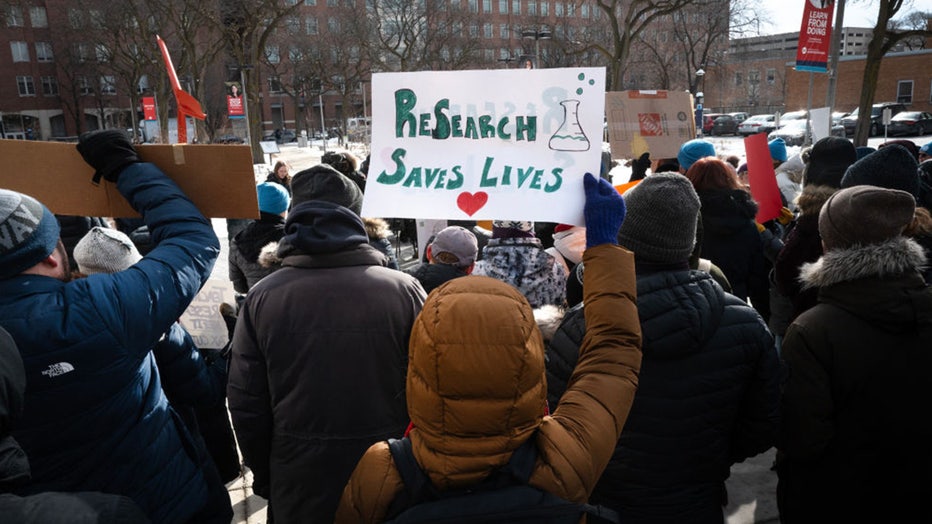Judge extends temporary block to NIH research funding cuts
Potential security failures in DOGE takeover
Rep. Val Hoyle, D-Ore., on Thursday said that she is leaving the Congressional Department of Government Efficiency (DOGE) Caucus due to Elon Musk's cost-cutting measures in the executive branch.
A federal judge on Friday extended a temporary block to the Trump administration’s drastic cuts in medical research funding, a move that many scientists say will endanger patients' lives and delay lifesaving advances in health care.
Earlier this month, U.S. District Judge Angel Kelley temporarily blocked the National Institutes of Health cuts from taking effect after separate lawsuits were filed by a group of 22 states plus organizations representing universities, hospitals and research institutions nationwide.
During a court hearing in Boston Friday, Kelley, who was appointed by Democratic President Joe Biden, extended that temporary block until she rules on an injunction, a more permanent decision.
"Whatever she decides, it’s not going to be the end of the story. It’s going to be appealed, probably all the way up to the Supreme Court because it’s of enormous consequence to the United States and to the rule of law," said Lawrence Gostin, a public health law expert at Georgetown University.
What does the NIH do?
The backstory:
The National Institutes of Health falls under the Department of Health and Human Services, which Trump’s Health Secretary Robert F. Kennedy Jr. oversees.
The NIH’s $48 billion budget funds medical research on vaccines, cancer and other diseases through competitive grants to researchers at institutions across the nation. The agency also conducts its own research with thousands of scientists working at NIH labs in Bethesda, Maryland.
RELATED: Commerce secretary shares Trump's 'goal' to abolish the IRS
The main funder of biomedical research, the NIH awarded more than 60,000 grants last year totaling about $35 billion. The total is divided into "direct" costs – covering researchers’ salaries and laboratory supplies – and "indirect" costs, the administrative and facility costs needed to support that work.
The Trump administration had dismissed those expenses as "overhead" but universities and hospitals argue they’re far more critical. They can include such things as electricity to operate sophisticated machinery, hazardous waste disposal, staff who ensure researchers follow safety rules and janitorial workers.
Different projects require different resources. Labs that handle dangerous viruses, for example, require more expensive safety precautions than a simpler experiment. So currently each grant’s amount of indirect costs is negotiated with NIH, some of them small while others reaching 50% or more of the total grant.
What is Trump’s new NIH policy?
Big picture view:
Under the Trump administration’s new policy, indirect costs would be capped at 15% immediately, for already awarded grants and new ones. NIH calculated that would save the agency $4 billion a year.

FILE - People including researchers from Chicago area universities gather on the University of Illinois Chicago (UIC) campus to voice concerns about the potential loss of federal funding for medical research on Feb. 19, 2025 in Chicago, Illinois. (Ph
It would strip research groups of hundreds of millions of dollars to cover so-called indirect expenses of studying Alzheimer's, cancer, heart disease and a host of other illnesses — anything from clinical trials of new treatments to basic lab research that is the foundation for discoveries.
RELATED: Why a ‘DOGE dividend’ stimulus check could be unlikely
What does the Trump administration say about NIH funding?
What they're saying:
In its own written arguments, the Trump administration said NIH has authority to alter the terms after awarding grants and that a federal courtroom isn’t the proper venue to arbitrate claims of breach of contract.
RELATED: Judge who was suspended from bench appointed to senior DOJ role: reports
States and researchers "have failed to show that they would suffer an irreparable injury," according to the administration motion.
What do the states say about NIH funding?
The other side:
The states and research groups say such a move is illegal, pointing to bipartisan congressional action during Trump’s first term to prohibit it.
"Yet here we are again," attorneys argued in a court motion, saying the NIH is "in open defiance" of what Congress decreed.
How would Trump’s NIH policy affect health care?
Dig deeper:
A motion filed in court cited a long list of examples of immediate harm in blue states and red states. They included the possibility of ending some clinical trials of treatments at the University of Wisconsin, Madison, that could leave "a population of patients with no viable alternative."
Officials at Johns Hopkins University were more blunt, saying the cut would end or require significantly scaling back research projects potentially including some of the 600 NIH-funded studies open to Hopkins patients.
"The care, treatments and medical breakthroughs provided to them and their families are not ‘overhead,’" university president Ron Daniels and Hopkins Medicine CEO Theodore DeWeese wrote to employees.
Attorneys also argued the cuts would harm state economies. The University of Florida would need to cut "critical research staffing" by about 45 people, while construction of a new research facility in Detroit expected to create nearly 500 new jobs could be paused or even abandoned, they wrote.
"Implementing this 15% cap will mean the abrupt loss of hundreds of millions of dollars that are already committed to employing tens of thousands of researchers and other workers, putting a halt to countless lifesaving health research and cutting-edge technology initiatives," the lawsuit said.
The Source: This report includes information from The Associated Press and previous LiveNow from FOX reporting.

